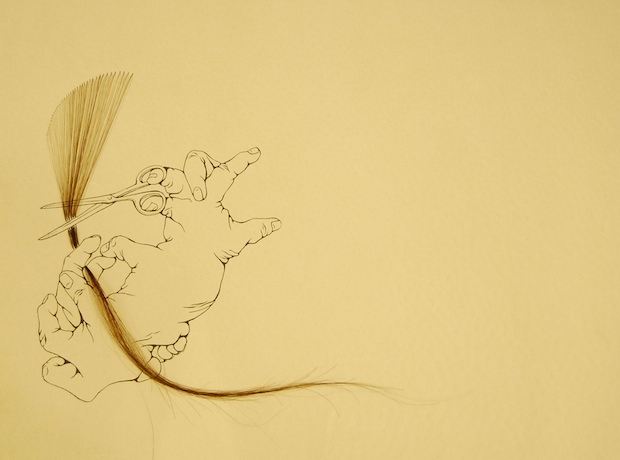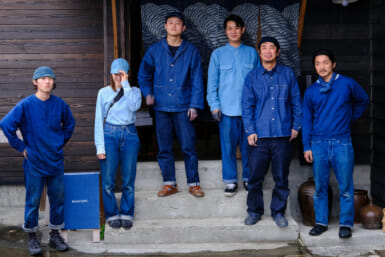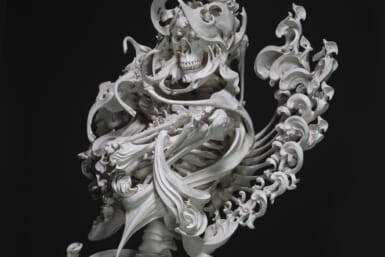From Rakunin, 2010. Japanese ink and hair on pig skin Tabaimo Courtesy of Gallery Koyanagi
- from “Rakunin”, 2010
Japanese ink and hair on pig skin
© Tabaimo / Courtesy of Gallery Koyanagi
Tabaimo isn’t interested in depicting the things you can normally see. She’s said as much in interviews. It’s the reason that one of her animated videos features a woman giving birth to a baby through her nose.
But what Tabaimo does like to depict are those things that writhe just below the surface of the everyday — whether they are the repressed psyches of otherwise “normal” people, or the fleshy workings of living things.
This, too, is at least part of the idea behind her many images of hands sprouting new fingers, splitting and dividing as though they were plants or microorganisms. Hands are strange and complex appendages to begin with, and Tabaimo makes them stranger by giving them lives of their own. They perform tasks, morph into other forms, collide and meld together or bud into new hands that perform other tasks. They become insectile creatures, independent of any human purpose, and as such, become both fascinating and strangely suspicious. What are these mobile creatures capable of doing without us?
This year, Tabaimo was chosen to represent Japan in the 54th Venice Biennale in 2011. I’ve long thought of Tabaimo as one of the best contemporary artists in Japan, and I can’t imagine anyone better to represent the country at the world’s biggest art event. So this is good news.
Tabaimo excels at taking familiar images of everyday urban life, and making them strange. While many are tempted to call it satire, there is little or no political positioning in her work. Tabaimo seems to feel that every space has any number of hidden things, events and meanings beneath its surface. She considers herself a “filter” for culture rather than a critic of it. But it seems to be the thoughts and anxieties of her culture that find themselves expressed in dream-like public spaces such as sento, trains, zebra crossings and public toilets.
We haven’t seen much of Tabaimo in Tokyo since her solo exhibition at the Hara Museum in 2006, but with her name connected to the Venice Biennale, you can expect to see a lot more.
First of all, there is the current show at Gallery Koyanagi. “Te Te Te” is both the title of the show, and the title of a series of drawings done on pig-leather and embroidered with human hair. (Is it the artist’s own? I have no idea.) Again, there is a sense, here, of hands doing autonomous things — they seem to be manipulating the hair; there may even be the hint that they are embroidering themselves.
Also on display are a number of handmade books, which are complex artworks in themselves with extra volumes cut from the inside pages, and original artworks inside as well as the leather cover. Leather is the order of the day. Most of the new works appear to be works of ink on leather, which appear to reveal layers of life between the layers of skin — insect parts, reaching nerves, internal organs and blood vessels. The show is also displaying her well-known film Guignorama.
Much has been made of the fact that Tabaimo’s drawings and animations draw heavily on the aesthetics of ukiyo-e prints. But here, the drawing style is almost beside the point. This is a show that illustrates there is more to Tabaimo than the requisites of anime and woodblock prints. There are things beneath the surface, waiting to be revealed.
-Owen Schaefer
Twitter
Photography









